Sprinter Barbara Howard on Life as an East Van P.E. Teacher
Barbara Howard (b. 1921) was the first black female athlete to represent Canada internationally. Today, at 94, she shares her East Van memories.
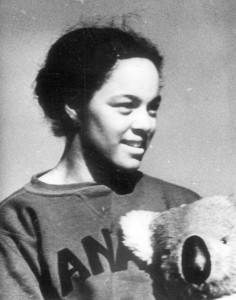
Image credit: M. James Matthew Skitt, public domain
I grew up at 10th and Nanaimo, on a big hill with a wonderful view, and every morning we would hear the trucks grind their way up that hill. That house is still there. I was raised British, and in that neighbourhood, there was the Irish family, the English family, the Scottish family, and us, the black family. My sister and three brothers and I went to the United Church and we were a big part of that community. My sister played the piano and wrote and performed plays; she was very talented. We went to Laura Secord School. The school is still there, doing wonderful work like breakfast for the kids. I have a good friend who teaches special needs there, so I stay in touch. I went there for four years, and then Britannia High School. I used to walk maybe a couple of miles to school, except when the weather was awful and I had to take the streetcar. My sister made some money typing and she’d give me some for the fare.
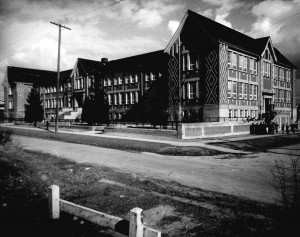
Image credit: M. James Skitt Matthews, public domain
In 1938, when I was 17, I broke the British Empire record for the 100-yard dash, so I was invited to compete in the British Empire Games in Sydney, Australia. It was exciting, but I didn’t realize at the time how much of a novelty I was considered. Australia didn’t allow foreigners in then, and because they saw very few black people they thought I was pretty special. My English neighbours at home had always hoped to visit cousins who lived in Australia, but decided that they could never afford this, and so I should be their emissary. I took letters and gifts from them to deliver to their cousins. While I was in Sydney, the daughter of one of these cousins died in an operation, and they thought it best if I told this news to my neighbours. That was hard. Her father was a jeweler, and he gave me these sterling silver pins of kangaroos and koala bears to give to my friends. On the boat trip back, we stopped in Fiji and I bought a big stalk of green bananas that we carried in the hold. When I got back to Britannia, I went from class to class with scissors, cutting off a ripe banana for each teacher.
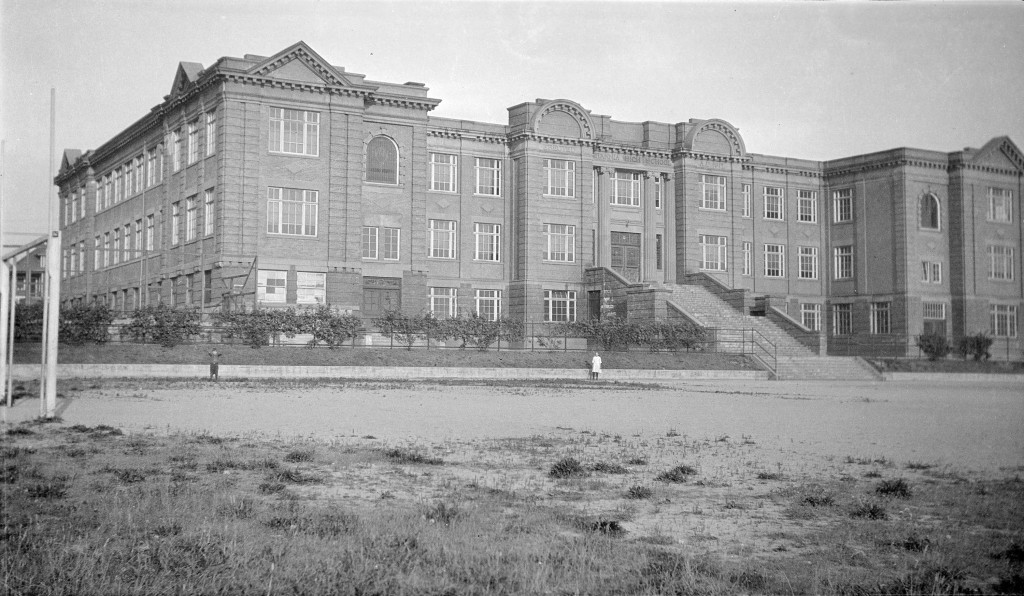
Image credit: Walter E. Frost, public domain
My father died when I was 8, and my uncle said he’d look after us. One time, he asked me what I wanted to be when I grew up and I said “A P.E. teacher” so he paid for my first year of Normal School. Once a month, the secretary would come and tell me they had my cheque. I thought I got my first job in Alberni from sending out resumes. It never occurred to me that people did not hire black teachers. About 10 years later, I found out that the principal of the Normal School thought so highly of me for being a hard worker that he went out of his way to get me that first job. When I came back to Vancouver, I had no trouble getting work as a substitute teacher.
So I waited every morning for that call at 7am to see if I’d have work that day. I think I made $35 per month. One time, they asked if I would take a boys’ class and I said sure. So I went to Strathcona School and exercised those boys a lot to keep them out of trouble. The school principal peeked in on us and, next thing, I found out the P.E. teacher they had— a very fine teacher— was retiring, and they wanted to hire me full time. I stayed for eight years.
I coached the volleyball team and the baseball team, and I taught five hours of P.E. each week. We practiced volleyball until 6:30pm, and the parents of my students had told them “Don’t let that teacher walk to the streetcar by herself!” So I would have 6 big boys escorting me the block to the streetcar after every practice.
The kids had P.E. three days a week. The first day was exercise, more like military exercises. I’d put a record on the windup record player and then have to keep winding it up. The next day, we had tumbling and vaulting with a spring board and everything, and the following day we had folk dancing. There were a lot of Ukrainian students there, and I knew they took classes after school to learn folk dancing. So they taught me some simple steps, and then I taught them to the whole class.
Every so often, the gypsies would come to Vancouver, and I’d learn dances from them. There was a very effective truant officer in Vancouver, a big woman who would visit the storefronts where the gypsies would set up shop to do palm readings (you knew where they were because they’d put up curtains in the windows and sit in front of them) and she’d get all their kids into school. They loved this! No other city asked them to come to school. There was one student— he seemed to always be in Grade Four— who taught me some dances which I simplified and taught the other students.
One time we were invited to UBC festival and we took 40 Grade Seven students to dance, wearing crepe paper around their heads to look like gypsies. But on the day, one of my best dancers was sick, which meant a set would be incomplete and that eight dancers would be unable to perform. Luckily, her younger sister, who had watched all of practicing, said she knew all the steps and she stepped in. Those were the Crump sisters. My church now has some funds to donate to the arts, and I asked them to make sure some it is allocated for folk dancing.
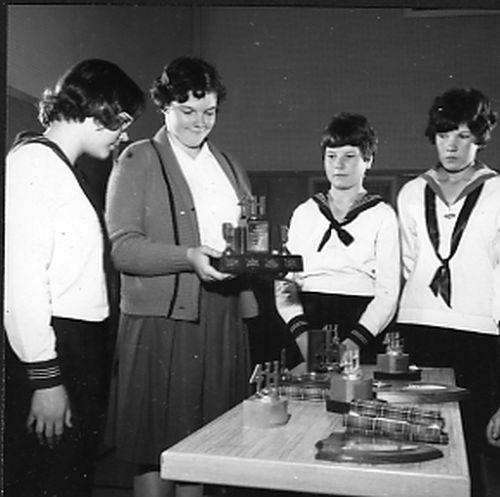
Image credit: United Church of Canada, CC, Flickr
When I was at Alberni, one of the United Church workers invited me to go to summer camp, and that’s when I started Canadian Girls in Training (CGIT). I went on to direct many camps. In 1942, when I must have still been going to Strathcona, my church was Grandview Trinity United on Victoria Drive. There was a big Japanese population at the United Church in Richmond, and they used to come to our dances. There was a Japanese family who lived across the street from us. When the Japanese were impounded at Hastings Park, our Young People’s Group held dances and entertainment for them at the park. They let us know when they were being sent into the Interior, and we went down to the train to see them off, waving goodbye. I still remember that. Some of them went to Ontario and some to Tashme, a camp they built near Hope.
As a CGIT leader, I went to Tashme to have a CGIT camp with them. The camp was down this long hill, and I could see them running up to the bus to meet me, laughing and waving. That was a wonderful experience. I had to get fingerprinted to get in there and things like that. And, for Thanksgiving, I went back to the camp, and the houses they had there weren’t even lined, they were more like barns. Being Japanese, they had built flower boxes, to bring some beauty to that place, and the RCMP would tear them down. Oh, it was awful! Tashme is gone now, because there was a slide, and it’s since been destroyed.
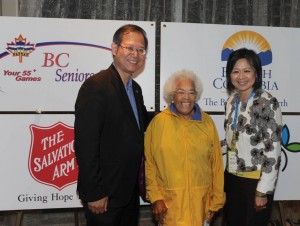
Image credit: The Province of British Columbia, CC, Flickr
I live on Capitol Hill now, in a beautiful home that my mother designed. I’m 94, and there aren’t many of my friends left around. Still, I’m fortunate to have my memories of friends and occasions, unlike some. A couple of years ago, they had a big reunion at the Hastings School and, every year now, they take me out for lunch. This year was the only one I missed it, due to poor health. Being a teacher, I traveled often and shared my travels with my students. One year, I went to Rome and sent each of my 22 students a card, and some of them still have that card. And some still have their report cards!
Oh, there’s always something. They painted a big mural of me on the side of the Britannia Centre–I never looked that tall, that lean, or that black! But it’s quite an honour. Last week, someone called me from Glasgow, the cite of the Commonwealth Games. She wanted me to say “Ready. Set. Go!” to start the play they were creating. So I did that. At the Commonwealth Games, all the sprinters were black girls. Every month, something special happens to keep me going. The NDP have named a scholarship after me for Grade 12 students. And now I’ve had this conversation with you.
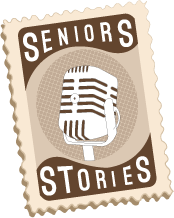



Leave a Reply